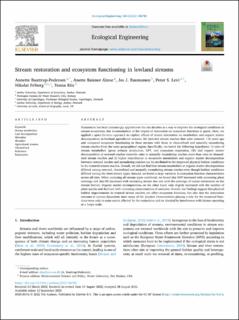| dc.contributor.author | Baattrup-Pedersen, Annette | |
| dc.contributor.author | Alnoe, Anette Baisner | |
| dc.contributor.author | Rasmussen, Jes Jessen | |
| dc.contributor.author | Levi, Peter S. | |
| dc.contributor.author | Friberg, Nikolai | |
| dc.contributor.author | Riis, Tenna | |
| dc.date.accessioned | 2023-03-10T10:34:49Z | |
| dc.date.available | 2023-03-10T10:34:49Z | |
| dc.date.created | 2022-10-25T14:28:41Z | |
| dc.date.issued | 2022 | |
| dc.identifier.citation | Ecological Engineering: The Journal of Ecotechnology. 2022, 184 . | en_US |
| dc.identifier.issn | 0925-8574 | |
| dc.identifier.uri | https://hdl.handle.net/11250/3057657 | |
| dc.description.abstract | Restoration has been increasingly applied over the last decades as a way to improve the ecological conditions in stream ecosystems, but documentation of the impact of restoration on ecosystem functions is sparse. Here, we applied a space-for-time approach to explore effects of stream restoration on metabolism and organic matter decomposition in lowland agricultural streams. We included stream reaches that were restored >10 years ago and compared ecosystem functioning in these streams with those in channelized and naturally meandering stream reaches from the same geographical region. Specifically, we tested the following hypotheses: 1) rates of stream metabolism (gross primary production, GPP, and ecosystem respiration, ER) and organic matter decomposition in restored reaches resemble rates in naturally meandering reaches more than rates in channelized stream reaches and 2) higher resemblance in ecosystem metabolism and organic matter decomposition between restored reaches and meandering reaches can be attributed to the improved physical habitat conditions in the restored stream reaches. Overall, we did not find that stream metabolism or organic matter decomposition differed among restored, channelized and naturally meandering stream reaches even though habitat conditions differed among the three stream types. Instead, we found a large variation in ecosystem function characteristics across all sites. When analyzing all stream types combined, we found that GPP increased with increasing plant coverage and that ER increased with increasing stream size and with the coverage of coarse substratum on the stream bottom. Organic matter decomposition, on the other hand, only slightly increased with the number of plant species and declined with increasing concentrations of nutrients. Overall, our findings suggest that physical habitat improvements in restored stream reaches can affect ecosystem functions, but also that the restoration outcome is context-dependent since many of the physical characteristics playing a role for the measured functions were only to some extent affected by the restoration and/or clouded by interference with factors operating at a larger-scale. | en_US |
| dc.language.iso | eng | en_US |
| dc.publisher | Elsevier | |
| dc.rights | Navngivelse 4.0 Internasjonal | * |
| dc.rights.uri | http://creativecommons.org/licenses/by/4.0/deed.no | * |
| dc.title | Stream restoration and ecosystem functioning in lowland streams | en_US |
| dc.title.alternative | Stream restoration and ecosystem functioning in lowland streams | en_US |
| dc.type | Peer reviewed | en_US |
| dc.type | Journal article | en_US |
| dc.description.version | publishedVersion | en_US |
| dc.rights.holder | © 2022 The Authors | |
| dc.source.pagenumber | 9 | en_US |
| dc.source.volume | 184 | en_US |
| dc.source.journal | Ecological Engineering: The Journal of Ecotechnology | en_US |
| dc.identifier.doi | 10.1016/j.ecoleng.2022.106782 | |
| dc.identifier.cristin | 2064891 | |
| dc.relation.project | EC/FP7/282656 | en_US |
| dc.relation.project | EC/H2020/101036337 | en_US |
| cristin.ispublished | true | |
| cristin.fulltext | original | |
| cristin.qualitycode | 1 | |

